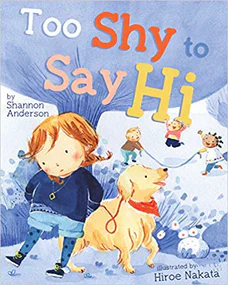Too Shy to Say Hi

Recommended Age Range: Preschool through 2nd grade.
Publisher's Summary:
Shelli used to be pretty content in her little world, thinking that her pet friends with feathers, fins, and fur were enough. Her bird would keep her company at home, her fish would hideaway in his cave, and her dog was the social butterfly of the neighborhood. But now, Shelli is determined to try to make friends with kids at school. Readers will relate as Shelli takes brave steps toward breaking out of her shell.

Dr. Annie's Takeaways
Recommended for: This book is a good read for children who want to be able to make friends and talk with unfamiliar people but who are anxious about it and sick of adults telling them to “just say hi” as if it were easy. It shares a couple of strategies for working up the courage to say hi (practicing in a mirror, taking a deep breath), and it models an exposure challenge
and subsequent decrease in Shelli’s worries following a positive outcome (she makes a friend!).
Would a child like it? Children who relate to Shelli would likely appreciate this book, even if it’s not the most fun story ever. It normalizes feeling anxious about saying hi and talking with unfamiliar people, and it presents a simple plan for preventing fear from stopping a child from making friends.
Evidence-Based Practices:
Exposure
Tone: Cheerful
Story Quality: This story is written in rhymes that, at times, have a bit of a contrived cadence. That said, it’s cute, cheerful, and it is likely to be relatable to many children who are anxious about making new friends. Shelli starts out comparing herself to the social proclivities of her pets. Unlike Shelli, her dog is a social butterfly, and her parrot finds it easy to say “hello,” but her fish gets her–he often hides out in his cave by himself. Over the course of the book, Shelli sets a goal of coming “out of [her] shell” and making a friend at school. She is realistically anxious about saying hi to a classmate and asking her to play at recess; she blushes and worries about what she’s going to say. Her new friend responds enthusiastically, and Shelli makes a friend. At the end of the book, there is an illustration of Shelli adding another fish to the tank with her fish who is shy, so he too has a friend. So cute.
Illustrations: Brightly colored, cheery watercolor illustrations.
Representation: Shelli is a White girl. Her new friend is a Black girl named Lupita. The kids in Shelli’s class are White, Brown, and Black. Shelli lives in a suburban or rural area. Shelli has a White parent with short hair (perhaps a dad, or a mom with short hair) who drives her to and from school.
Psychological Practices: Shelli sets herself a goal–to talk to another student at school in order to make a friend. There are no adults involved at all. No one pressures her to be more social; her decision to make a friend appears to be entirely self-motivated. The night before she returns to school, she practices waving and saying hi to herself in the mirror. When she walks into the classroom, her “stomach is in knots,” and she blushes. She takes a deep breath, and asks to sit next to a girl in her class. After this goes well, she feels a bit braver and asks the girl if she’d like to play at recess. This also goes well, and Shelli has “the very best day of all.” She learns that she doesn’t have to “[have] a speech prepared” and can just smile and say hello to start a conversation with a new friend.
Concerns: When Shelli is being driven to school, she has some doubts about whether she’ll be able to go through with her plan to say hi to someone. She reminds herself that it won’t feel good if she “chicken[s] out,” and she recommits herself to trying to talk with someone before the day is over. I appreciate that the book shows Shelli’s anxiety here, as well as her strategy of reminding herself of why facing her fears is worth it (she really wants to make some friends). My concern is with the phrase “chicken out.” It encourages children to feel ashamed of being anxious, and it’s derogatory. Many children with anxiety beat themselves up for backing out of things or not being able to do things they want to be able to do. Berating themselves isn’t a helpful motivating strategy, and it can negatively impact children’s self-esteem and mood. It’s much more effective to focus on how good it will feel if a child follows through with their goal.
